The following is from the Autumn 2020 issue of Vision.
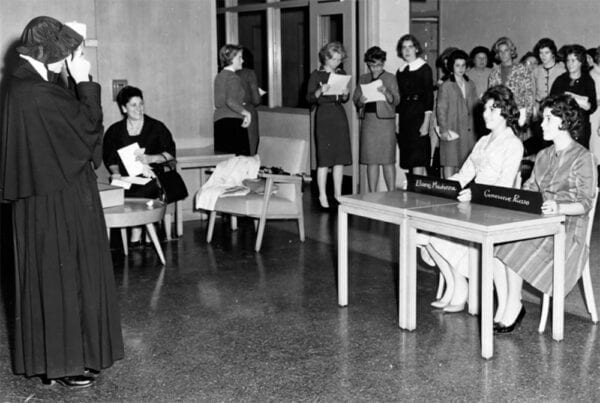
Sr. Rose Maria Laverty photographed registration of the first class of Elizabeth Seton College students.
The Charity of Christ impels the Sisters of Charity to provide every service in our power. In 1898, that meant opening the first Catholic secondary school in Yonkers, Seton Academic Institute. After several incarnations (including “The Pines” on the northeast corner of Mount Saint Vincent) it became Elizabeth Seton School.
In 1951 it moved to the former W.B. Thompson estate on North Broadway in Yonkers, where it provided an outstanding education to hundreds of young women (including this writer). Boarders from the U.S. and other countries lived in Alder Manor, an Italian Renaissance Revival mansion furnished with tapestries, Italian porcelain bowls and Ming Dynasty vases. Commuters and boarders attended classes in a modern brick building overlooking the Hudson River and strolled at lunchtime in a Greco-Roman sculpture garden adjoining the Manor.
By 1960 a growing number of students in a booming economy were seeking college courses and job skills. The Congregation was asked to transform Seton into a two-year college, the first such college under Catholic auspices in New York State. By a happy coincidence, the state official charged with approving the required charter change was the father of Sr. Mary Ellen Brosnan. Chancellor John Brosnan’s family had close ties to the Sisters of Charity since a relative was taught by the Sisters in 1862. The charter was speedily granted.
Seton College’s opening in September 1961 pioneered a new approach to higher education even before the growth of the state’s Community College system. The curriculum offered a basic liberal arts major, with both transfer and terminal degrees, as well as career majors in radio/TV, merchandising, nursing and other fields.
Under Seton’s first President, Sr. Miriam Imelda Kieley, Bosch Residence Hall was built, and Middle States accreditation was granted. Successive Presidents—Sisters Mary Elizabeth Kelly, Eileen Farley and Mary Ellen Brosnan—encouraged creative approaches adapted to the changing needs of diverse students, such as weekend and adult programs, branch campuses in Manhattan, co-education and experiments in experiential learning.
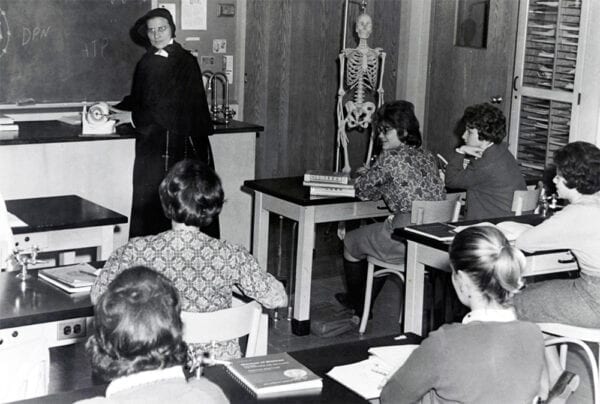
Sr. Francis Marita Sabara, member of the first faculty, taught science.
Sr. Francis Marita Sabara “had the privilege of being invited to join the first faculty at ESC,” teaching science and biology. Besides the strong academic curriculum, she remembers the “great (dramatic) productions” of Sr. Marian Francis Harriott, the “joyous choral and concert” performances directed by Sr. Thomas Mary (Helen) O’Connor, and the art department led by Sisters Marie Mercedes (Catherine) Murphy and Christine Marie Murphy. Only Sisters Francis and Therese Donnelly remain from that inaugural faculty roster.
Other memorable teachers mentioned by graduates were Anne Murray, Ingeborg Torrup, George Hoenig, Pat Bree and Sisters Mildred Azevedo, Margaret Beaudette, Marie Irene Breheny, Marian James Deegan, Alice Regina Epes, Irene Fugazy, Regina Kraft and Katherine Talbot.
Sr. Ann Citarella (who attended Seton in her pre-SC days) vividly remembers Sr. Francis calling the class to look out the window at ice chunks on the Hudson River moving in two directions at once, a fact that continues to amaze her. Her years at Seton marked Sr. Ann’s first encounter with the Sisters of Charity, whom she joined almost 20 years later.
As a novice and junior professed attending Seton, Sr. Andrea Dixon recalls the atmosphere of beauty and freedom she found there. Alder Manor’s tapestries and the Greek garden’s huge stone pillars brought to life treasures she had only read about.
Associate Barbara Stasz Sweeney remembers Seton’s “welcoming” atmosphere, “magnificent campus,… the flora, the gardens, the view” and the “many opportunities to feel connected.” Teachers were “engaged and well prepared,… always challenging us to go beyond the obvious and to think outside the box.”
Associate Sandy Figueroa described the faculty as “open and exciting.” She credits her English teacher at Seton with sharpening her skills in clear, creative writing and awakening her interest in Eugene O’Neill, the subject of one of her term papers.
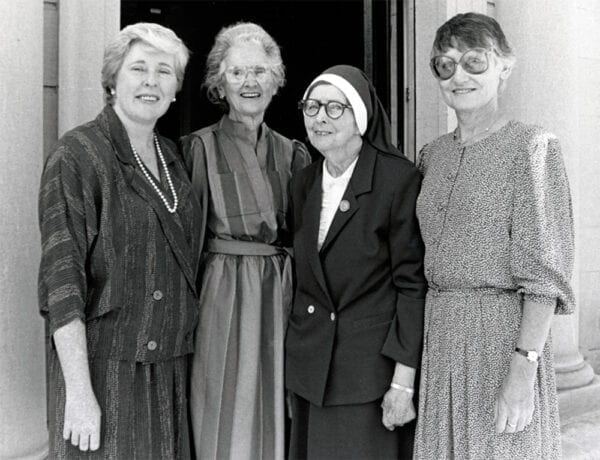
The four Presidents of Elizabeth Seton College, left to right: Eileen Farley, (1971–1975); Sr. Mary Elizabeth Kelly (1966–1971); Sr. Miriam Imelda Kieley (1960–1966); Sr. Mary Ellen Brosnan (1975–1989)
Sr. Mary Eucharia Carrigan served as a librarian at Seton for 20 years until it closed. She recalls the “fantastic students,” especially the adults in the nursing program. “They had homes and families to care for, plus a job.… They were determined to keep up with their studies and get degrees.”
Memories of students also remain vivid for Sr. Barbara Srozenski, who taught chemistry to student nurses. After their shift at Calvary Hospital ended at 3 p.m., they hurried to Seton for a 4:30 to 6:30 class, always on time, always with assignments done. As they shared their nursing experiences in class, Sr. Barbara “…became the student and marveled at the way they integrated book knowledge with loving, compassionate care.”
Elizabeth Seton College remained an independent institution until its merger with Iona College in 1989. Regrettably, the Seton campus was closed just two years later; the entire property was sold by Iona in 1995.
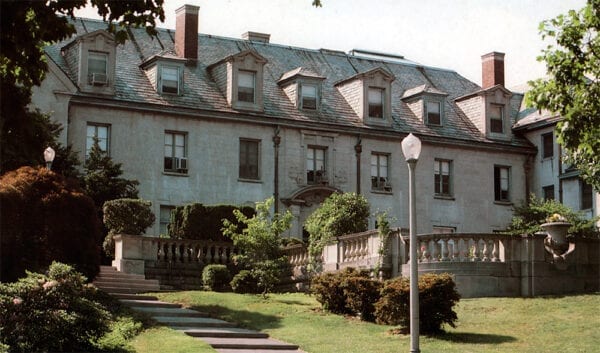
Elizabeth Seton College was located at the former W.B. Thompson estate on North Broadway in Yonkers.
2020 marks the 60th anniversary of Seton College’s founding. In its brief but spectacular history, Seton attracted women and men of varied cultural, economic and social backgrounds; talk-show host and journalist Denise Richardson and actress Jane Curtin are among its more famous alumni/ae, but hundreds more witness to its lasting legacy. Seton’s programs responded to the need for a fresh approach to higher education, especially for the “nontraditional” students whom it was Seton’s mission to serve. That need still exists. Sixty years ago (and long before), the Sisters of Charity were part of the solution. Their commitment to education continues in innovative ways, as this issue of Vision proudly describes.
By Regina Bechtle, SC, with contributions from: Associates Sandy Figueroa, Barbara Stasz Sweeny; Sisters M. Eucharia Carrigan, Ann Citarella, Andrea Dixon, Francis Marita Sabara and Barbara Srozenski
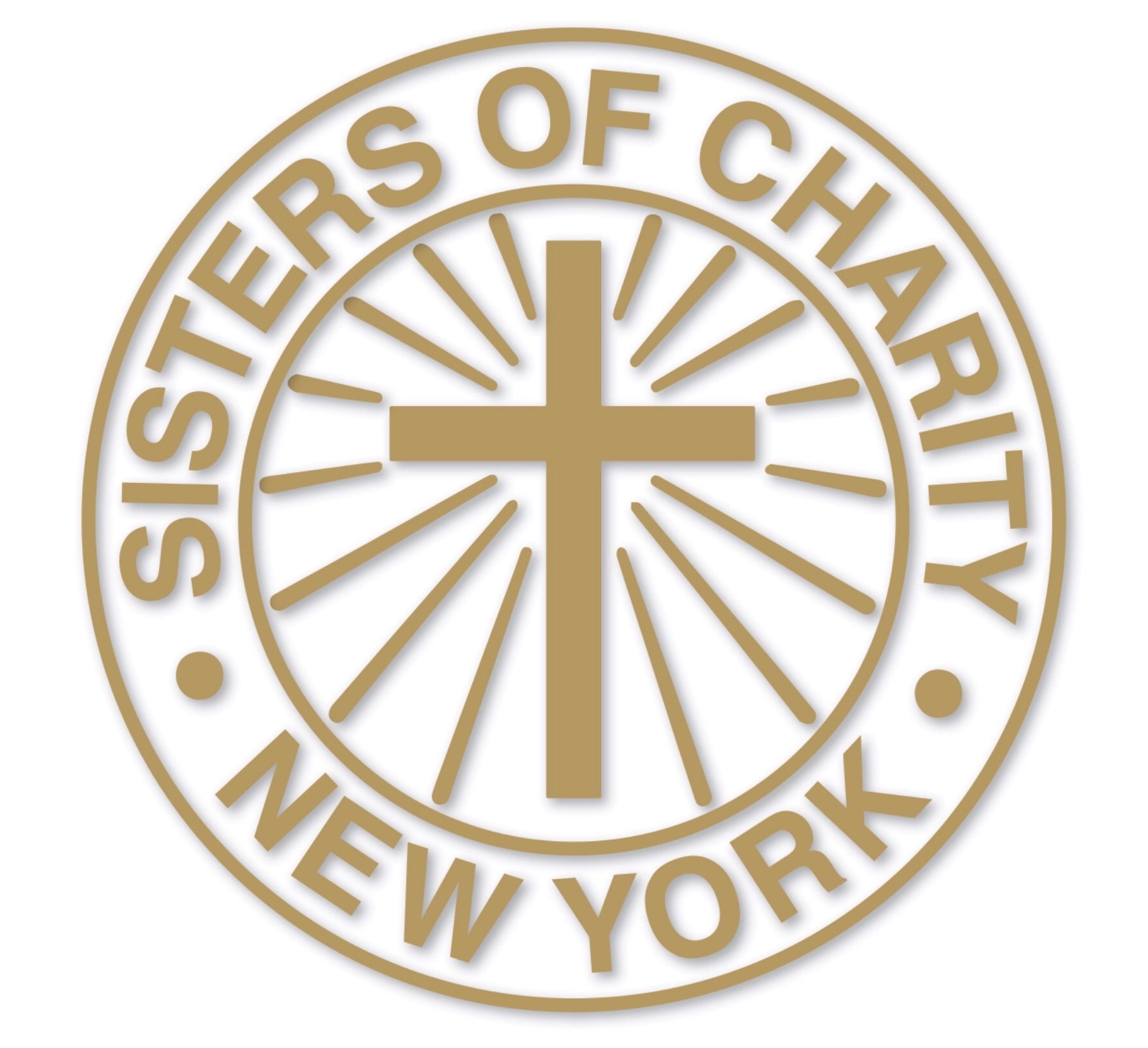
Thank you, Sisters, for sharing this wonderful, interesting history with us. I love reading about the history of the Sisters of Charity – all you have accomplished and all that you have shared, making so many lives enriched with your faith, hope, charity, and hard work. You continue to make this troubled world a better place.
Thank you for your kind words, Ms. Andersen. We love sharing our history, and happy to know you love reading it! Throughout our history and today, our work was made possible by the many who dedicate their time, energy and support.
I graduated from Seton College in 1967. My years there prepared me for the experience of earning bachelor’s and master’s degrees from SUNY Albany. The incredible faculty not only imparted an education but also an attitude that has been invaluable in my life.
I was also blessed to return to Seton in 1970 and serve 3 years as Director of Public Relations. It was my pleasure to spread the good news about Seton. I moved on from Seton to spend my life as a teacher in Catholic elementary schools, a Catholic high school Director of Development, and even did 10 years as a Catholic school principal. All of my careers were inspired and made possible by Elizabeth Seton College and the incredible faculty and administration.
My late Aunt Helen (Sister Virginia Maria McGovern, SC) taught at Seton for 25 years. Our family attended many events there over the years, including my sister Margaret’s wedding reception in December 1979.
she taught me ! Sr. Virginia McGovern. i loved her
Sr. Virginia was so friendly in the classroom but when she visited us with her natural sister
the late Sr. Mary Margaret McGovern SC, she would grill us 6 kids – how do you spell this word, what is the capital of this country, what are the Joyful Mysteries – while Aunt Bridget (Sr. Margaret) would play Old Maid and Monopoly and fun games. Oh what such happy memories.
Very special years- memories and friends
I gradúated from Elizabeth Seton College in 1968. I will always remember those two beautiful years there: the sisters, the classes, my friends: Kathy, Joan, Mary, Flo, the dorm, the castle, the gardens, the entire ambiance, I loved it all!
Thank you Sisters;
Thank you Elizabeth Seton College.
I too have fond memories of my freshman year, 1967-68 at Seton. The photos of the Thompson Estate certainly were nostalgic.
I graduated from Elizabeth Seton in 1978. I am great full for the enrichment, friends and experienced that I gained. It was probably the best experience that I had. Thank you Sisters.
Elizabeth Seton College later became Tara Circle – an Irish non-profit. My County Cavan Association of New York held a few picnics and Gaelic Football games there. I especially remember the pig roast and the Irish music playing.
I attended Elizabeth Seton College from 1975 to 1977. I graduated with an AS Degree with a major in Medical Laboratory Technology and was on the Dean’s List for one semester. I had a room in Bosch Hall and could see the Hudson River from my window.
I had a successful career as a Med Tech thanks to the superior education I received during those 2 years.
As the dean of Elizabeth Seton College from 1976 until 1986, I had the wonderful opportunity to work with many special Sisters of Charity including Sister Mary Ellen Brosnan, Sister Virginia McGovern, Sister Irene Breheny, Sister Eurcharia Carrigan, Sister Therese Donnelly, Sister Barbara Srozenski, and Sister Marian James Deegan. The faculty who were not Sisters of Charity and the students were also very special. In fact, Elizabeth Seton College was a very special place. I would be glad to hear from anyone who wishes to be in contact with me. You can email me at RLN@yu.edu .
Hi Richael – Sister Virginia McGovern is my late aunt, the sister of my late dad James and also the sister of the late Sister Mary Margaret McGovern, SC. My Aunt Helen (Sr. Virginia) taught at Elizabeth Seton for 25 years. My family went to many affairs and functions there, including my sister Margaret’s wedding reception in December 1979. After it sadly closed, my County Cavan Association of New York (an Irish social club comprised of those born in County Cavan or (like me) a descendant of Cavan people) held our annual picnic on the grounds. Happy Christmas to you and yours. Regards, Michael McGovern (Long Island, New York).
Hi Michael,
I think I remember meeting you. Of the Sisters I mentioned, your Aunt Helen was the one I was closest to. I visited her in the hospital during her final illness and attended her funeral. She was a wonderful person and a wonderful friend. After 24 years, I still miss her.
Very best wishes to you and your family for an excellent Christmas and a healthy and happy new year.
Richard
Hello again Richard. A quick story about Aunt Helen. Her dad was born in the Cavan village of Glangevlin but also loved the Cavan village of Virginia very much. Her birth name is Helen Virginia (Confirmation name is Anastasia) after the village. She then took the religious name of Virginia Maria (again the name Virginia) which means the “Virgin Mary”. Cool, eh?
Also, she is a year and a few months older than my Aunt Bee (Sr. Mary Margaret – her sister). When Aunt Helen was to make her First Communion, her mother (also from the Cavan Village of Glangevlin and born a McGovern) asked the pastor if Aunt Bee could also make her First Communion a year earlier. The pastor said OK. I have a photo of both posing together in their Communion dresses.
Hi Michael,
An interesting story about your grandmother and the priest. I had the impression that priests in that era went by the book, but that may be my ignorance. Actually, if your grandmother had the forceful personality of your Aunt Helen, very few priests would have been able to deny her request. I recall what your aunt told me about her very first teaching assignment, when she was I think only about nineteen years old. Her being able to take charge of the challenge that was presented to her was amazing–but did not surprise me.
Would it be easy for you to scan that photo and email it to me (RLN@yu.edu)? If so, I would love to see it.
Best wishes,
Richard
Hi Michael,
An interesting story about your grandmother and the priest. I had the impression that priests in that era went by the book, but that may be my ignorance. Actually, if your grandmother had the forceful personality of your Aunt Helen, very few priests would have been able to deny her request. I recall what your aunt told me about her very first teaching assignment, when she was I think only about nineteen years old. Her being able to take charge of the challenge that was presented to her was amazing–but did not surprise me.
Would it be easy for you to scan that photo and email it to me (RLN@yu.edu)? If so, I would love to see it.
Best wishes,
Richard
Hello again Michael,
I tried to respond to you yesterday morning, but I see my reply isn’t posted so I must have had trouble with the technology. I enjoyed what you wrote about your aunts’ First Communion. I’m imagining that your grandmother had the kind of forceful personality that your Aunt Helen had, which would have made it difficult for the pastor to say “no” to her. If it’s easy for you to scan that photo & email it to me (RLN@yu.edu), I would love to see it.
Best wishes,
Richard
My mother graduated from Seaton Hall School, a high school, in 1944. She was better educated than most people with college degrees. She gained a true love of learning